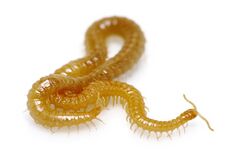Biology:Geophilomorpha
| Geophilomorpha | |
|---|---|

| |
| A western yellow centipede (Haplophilus subterraneanus) | |
| Scientific classification | |
| Domain: | Eukaryota |
| Kingdom: | Animalia |
| Phylum: | Arthropoda |
| Subphylum: | Myriapoda |
| Class: | Chilopoda |
| (unranked): | Pleurostigmomorpha |
| Order: | Geophilomorpha |
| Suborders | |
The Geophilomorpha, commonly known as soil centipedes,[1] are epimorphic[2] and bear upwards of 27 leg-bearing segments. They are eyeless and blind, and bear spiracles on all leg-bearing segments—in contrast to other groups, which usually bear them only on their 3rd, 5th, 8th, 10th, 12th, and 14th segments—a "mid-body break", accompanied by a change in tagmatic shape, occurring roughly at the interchange from odd to even segments. This group is the most diverse centipede order, with 230 genera.[3] Centipedes in this order each have an odd number of leg-bearing segments ranging from 27 (in the genus Schendylops)[4] to 191 (in the species Gonibregmatus plurimipes).[2] They also have 14–segmented antennae. This order is a monophyletic group including two suborders: the monophyletic Placodesmata, which contains Mecistocephalidae, and Adesmata, which includes the superfamilies Himantarioidea (Oryidae, Himantariidae, and Schendylidae, including Ballophilidae) and Geophiloidea (Zelanophilidae, Gonibregmatidae including Eriphantidae and Neogeophilidae, and Geophilidae including Aphilodontidae, Dignathodontidae, Linotaeniidae, Chilenophilinae,[5] and Macronicophilidae).[6] Segment number is usually fixed by species in the family Mecistocephalidae, unlike the case in other families in this order, in which the segment number usually varies within each species.[7] The name "Geophilomorpha" is from Ancient Greek roots meaning "formed to love the earth."[8]
References
- ↑ "Soil Centipedes (Order Geophilomorpha)" (in en). https://www.inaturalist.org/taxa/67662-Geophilomorpha.
- ↑ 2.0 2.1 Fusco, Giuseppe (2005). "Trunk segment numbers and sequential segmentation in myriapods" (in en). Evolution & Development 7 (6): 608–617. doi:10.1111/j.1525-142X.2005.05064.x. ISSN 1525-142X. PMID 16336414.
- ↑ "ITIS - Report: Geophilomorpha" (in en-US). https://www.itis.gov/servlet/SingleRpt/SingleRpt?search_topic=TSN&search_value=154404#null.
- ↑ Pereira, Luis Alberto (2012). "Discovery of a second Geophilomorph species (Myriapoda: Chilopoda) having twenty-seven leg-bearing segments, the lowest number recorded up to the present in the centipede order geophilomorpha". Papéis Avulsos de Zoologia 53 (13): 163‑185. doi:10.1590/S0031-10492013001300001.
- ↑ Crabill, Ralph Edwin (1954). "A conspectus of the northeastern North American species of Geophilus (Chilopoda Geophilomorpha Geophilidae)". Proceedings of the Entomological Society of Washington 56: 172–188. https://www.biodiversitylibrary.org/page/16179233. Retrieved 23 October 2021.
- ↑ Bonato, Lucio (2014). "Phylogeny of Geophilomorpha (Chilopoda) inferred from new morphological and molecular evidence". Cladistics 30 (5): 485–507. doi:10.1111/cla.12060. PMID 34794246.
- ↑ Minelli, Alessandro (2020). "Arthropod segments and segmentation – lessons from myriapods, and open questions". Opuscula Zoologica 51(S2): 7–21. doi:10.18348/opzool.2020.S2.7. http://opuscula.elte.hu/PDF/Tomus51_S2/Op_%20Minelli_Arthropod_segmentation.pdf.
- ↑ Scarborough, John (February 19, 1992). Medical and Biological Terminologies: Classical Origins. University of Oklahoma Press. ISBN 9780806130293. https://books.google.com/books?id=hjwN65nZBE0C&dq=Geophilomorpha&pg=PA83.
Wikidata ☰ Q2664614 entry
 |

